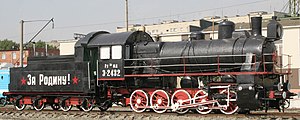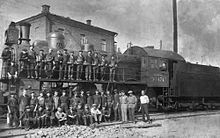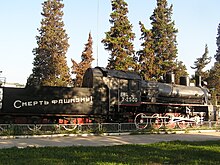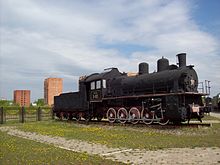Russian series Э
| Russian series Э | |
|---|---|
|
Э-2432
|
|
| Numbering: | different numbering |
| Number: | Э: 1528 Э г : 700 Э ш : 500 |
| Manufacturer: | Class Э: Locomotive factory Luhansk , Sormovo , Charkow , Kolomna , Brjansk , Nevsky Class Э г : several German companies Class Э ш : NOHAB |
| Year of construction (s): | 1912-1924 |
| Retirement: | unknown |
| Axis formula : | E h2 |
| Gauge : | 1524 mm 1435 mm |
| Length: | 11,455-11,906 mm |
| Service mass: | 81.2-85.6 t |
| Friction mass: | 81.2-85.6 t |
| Wheel set mass : | 16-17.5 t |
| Top speed: | 55 km / h, later 65 km / h |
| Indexed performance : | 920-1,300 hp |
| Starting tractive effort: | 18,100-19,500 kp |
| Driving wheel diameter: | 1320 mm |
| Control type : | Heusinger |
| Number of cylinders: | 2 |
| Cylinder diameter: | first 30 locomotives: 600 mm years of construction until 1917: 630 mm 650 mm |
| Piston stroke: | 700 mm |
| Boiler overpressure: | 12-14 bar |
| Grate area: | 4.2 m² |
| Superheater area : | 48.7-72 m² |
| Evaporation heating surface: | 180.3-207.1 m² |
| Tender: | Standard tender Putilow 4-axled |
| Locomotive brake: | direct acting air brake |
| Train brake: | indirectly acting compressed air brake |
| Particularities: | the first 15 locomotives are oil- fired, all other locomotives are coal-fired |
The steam locomotives of the class Э (German transcription E) were built for several railway companies of the Russian Empire in Russian broad gauge and were later procured by the Soviet Railways (SŽD). The locomotives of the series Э are considered to be the first steam locomotives to be built in the Russian Empire with five coupled axles; they were preferably used in freight train service nationwide on non-electrified routes. Together with the successor series Э у, м, р , almost 11,000 copies were produced. The steam locomotive series Э is thus the most frequently built steam locomotive in the world.
prehistory
All over Europe, the train loads of freight trains increased dramatically in the 1890s. At the same time, the rail load could not be increased arbitrarily, so that an increase in performance was only possible by equipping the steam locomotives with five driven axles. While the development of the first locomotive with five driven axles in Württemberg in 1895 was not yet consistently successful ( Württembergische G ), the breakthrough came around 1900 with the kkStB 180 . Laterally movable coupling axles based on the Gölsdorf system made it possible.
In Russia, the situation in the transport sector was no different. The superstructure was mostly light, which is why an urgently needed enlargement of the boiler was impossible on the previous chassis. The Russian class Baureihe with its 1'D wheel arrangement proved to be the best variant in these conditions around 1905. The locomotive was usable for not too heavy freight and passenger trains.
After the train loads increased more and more, the Щ series locomotives reached their performance limits . That was the basis for building a steam locomotive with five driven axles.
Project planning
Sketch project planning
The first request for the new freight locomotive with the E wheel arrangement came from the Russian Southeastern Railways, but the execution was rejected. In the period that followed, the Privolschskaja schelesnaja doroga claimed the new steam locomotive, class Э, on the grounds of its more demanding route profile. Your request was not accepted on the grounds that the Щ series had just gone into series production. The real reason for the expert commission of the Ministry of Transport under the chairmanship of Shchukin was that the lateral shiftability of the axles according to the Gölsdorf system , especially their behavior during arching, had to be examined first.
In 1909 the Vladikavkas Railway (Wladikawkasskaja schelesnaja doroga) brought in another request for a new freight locomotive with the E-wheel arrangement. The new Щ series locomotives could no longer cope with the loads of the increasingly heavy trains, and at the same time the superstructure could not be reinforced. The only decision in this situation was to develop a new locomotive with the E wheel arrangement.
Sketch design of the Vladikavkaz Railway
The sketch project of the new locomotive with the wheel arrangement E was put together under the direction of the technical office of the railway company under its head Wacław Łopuszyński . The new locomotive was intended for freight traffic and should have the following parameters: It should have a boiler with a rear boiler according to the Belpaire system, the grate area should be 4 m² and the complete evaporation area 164 m². Superheated steam with a dual steam superheater type Schmidt with a superheater area of 45 m² should be used. The cylinder diameter should be 590 mm, the piston stroke 700 mm and the coupling wheel diameter 1300 mm. Based on the example of the kkSt series 180, the first, third and fifth axes should be designed to be laterally displaceable, which should enable safe passage through arcs up to a radius of 160 meters. This drive would have required the fourth coupling axle to be designed as a drive axle, as it has to be fixed in the frame. That would have led to very long and therefore heavy drive rods.
The sketch project was accompanied by thoroughly explained sketches. After submitting the project to the Ministry of Transport under the chairmanship of Shchukin, doubts were expressed about the casual driving on narrow track curves, but the decision was ultimately positive.
Work planning
For the creation of the work project, the sketch parameters of the steam locomotive with the wheel arrangement E, carried out by the Vladikavkaser Railway, were given to the Luhansk locomotive factory . This made the following changes; the grate area was increased from 4 m² to 4.2 m², the complete evaporation area from 164 m² to 194.4 m², the superheater heating area from 45 m² to 52.6 m². The central axis of the boiler was raised to a level of 3100 mm above sea level, this allowed an increase in the depth of the combustion chamber. The cylinder diameter increased to 600 mm. The wheel diameter when new was increased to 1320 mm by increasing the thickness of the wheel tires. In addition, the chassis was changed; the third coupling axle was designed as a driving axle and without flange, so only the first and fifth coupling axles could be laterally shifted ± 22 millimeters. For better guidance on the track, they received reset devices. This suggestion by the first engineer of the Luhansk Locomotive Factory later enabled the new steam locomotive to run freely through curved tracks up to a radius of 150 m.
In addition, the Luhansk Locomotive Works created two other variants of the project; One with a two-cylinder composite steam engine , the second, as a first application in Russia, was to have a radial rear boiler as a replacement for the heavy Belpaire standing boiler. With this description it can be assumed that this could have been a version with a Brotan kettle . Ultimately, the machines were only built with Belpaire standing boilers and simple steam expansion.
These three versions came back to the Ministry of Transport in 1910, chaired by Shchukin. The project was successfully completed on October 29, 1911.
Production of the locomotives
Production for the Vladikavkaz Railway
In 1912, the Luhansk locomotive factory delivered the first 15 machines to the Vladikavkaser Railway . These were immediately used for factory traffic in the oil processing industry. The first machines were delivered without a tender and were given a standard oil-fired tender from the Vladikavkaz Railway . In the period around 1915–1918, the locomotives were given a uniform four-axle tender from the Putilow works . This tender was the future for all deliveries of the locomotive and the successor series Э у, м, р including the series O , and Щ С used. It had a tender front wall to protect the locomotive personnel when driving the tender ahead.
The steam locomotives were able to demonstrate good operational quality. Only the cylinder diameter was criticized.
Production for other railway companies
The next delivery of locomotives for the Donetsk region followed in 1913 . These were carried out with coal firing and initially with a cylinder diameter of 630 mm. This design was changed again around 1914, as this diameter limited the pulling power of the locomotive too much. From this time on, the locomotives were delivered with a cylinder diameter of 650 mm. The previously built machines were adapted.
In 1914, after evaluating the operating results of the locomotives, it was determined that they were superior to the Щ series. It was therefore decided not to continue to manufacture this series, but to only use the Э series for the needs of the other railway companies . Until 1914, the development and production were exclusively in the Luhansk locomotive factory. From 1915 production began in the factories in Sormowo , Charkow , Kolomna , Bryansk and Nevsky . From 1912 to 1917 a total of 1528 locomotives were built.
During the manufacturing period, there were no changes to the design. This concerned the introduction of the compressed air brake for locomotive and train with a double-acting air pump type tandem . Three different injectors were used during the construction period : Friedmann, Sjablova and Baschkina. From 1916 a so-called lightened design was implemented, in which the axle pressure was achieved by selecting smaller sheet metal thicknesses for various parts, such as the jacket of the fire box, the fire box itself, the long boiler and the side plates of the main frame (bar frame). From 1917 a war version of the locomotive appeared, in which parts previously made of copper, such as the fire box, were replaced by steel ones. The number of heating and smoke pipes has also been changed on this machine. Some minor changes resulted from customer requests, such as the equipment of the steam engine, sandpit, chimney or the specific circumstances of the respective manufacturing plants.
When steam locomotive production was resumed after the turmoil of the revolution, the government of that time ordered 700 locomotives under the designation Э г from various German plants and 500 locomotives under the designation Э ш from Nydqvist och Holm in Sweden . These constructions were based on the drawings of the 1917 series, so that they can be referred to as the Э series . The frames were designed in such a way that the machines could be transported on standard-gauge transfer wheel sets from the manufacturing plants to the lane changing stations.
In 1924 the Kolomna locomotive factory began again with the production of steam locomotives of the Э series , which were transferred to the Э M and Э u series in the following years . For these locomotives see the SŽD series Э.
business
The steam locomotives of the series Э were spread throughout the Russian Empire and there freely used on all routes, with the exception of Turkestan , Krasnoyarsk and Far East . In the first period of industrialization in the USSR (1925–1935), locomotives took over the main transport of goods.
In the transitional period of the reconstruction of the railway system (1935-1936) they were used to accelerate freight traffic on main highways until they were replaced there by more powerful machines such as the ФД .
In the time of the Great Patriotic War , the locomotives were primarily used as column locomotives, especially as a reserve to ensure the trouble-free transport of war on intermediate front lines with constant threat from the enemy air force and for accelerated restoration. This task required simple constructions, sufficiently powerful and fast-running machines.
Further development
In the time of the USSR , the locomotives were out of the base construction of this locomotive Э M , Э u and Э P developed, manufactured in Europe in large numbers and showed the good quality of the base construction. The production of these locomotives dragged on until 1955.
When higher axle loads became possible after the expansion of the main lines, locomotives up to the size of the ФД were developed from this basic version.
Whereabouts
With a number of around 11,000 locomotives, many machines have been preserved, including one each from 1915 and one from 1917: the Э 2432 in the Saratov depot and the Эл 2500 in Sevastopol . The Э M 730-31 is in the Russian Railway Museum in St. Petersburg . Three locomotives from the production time in Sweden have been preserved as memorials. The majority of the locomotives preserved as memorials are the Э u (11 units), the Э M (14 units) and the Э P (8 units).
Two locomotives of the Э u and four locomotives of the Э P have been preserved in working order.
See also
Web links
Individual evidence
- ^ Erik Sundström, Rolf Sten: Ånglok tillverkade av Nydqvist & Holm. In: historiskt.nu. October 17, 2007, accessed May 24, 2019 (Swedish).
- ↑ http://www.bahnbilder.de/bild/russland~dampfloks~1069m-em/1051363/dampflok-1069m-730-31-im-russischen-eisenbahnmuseums.html







